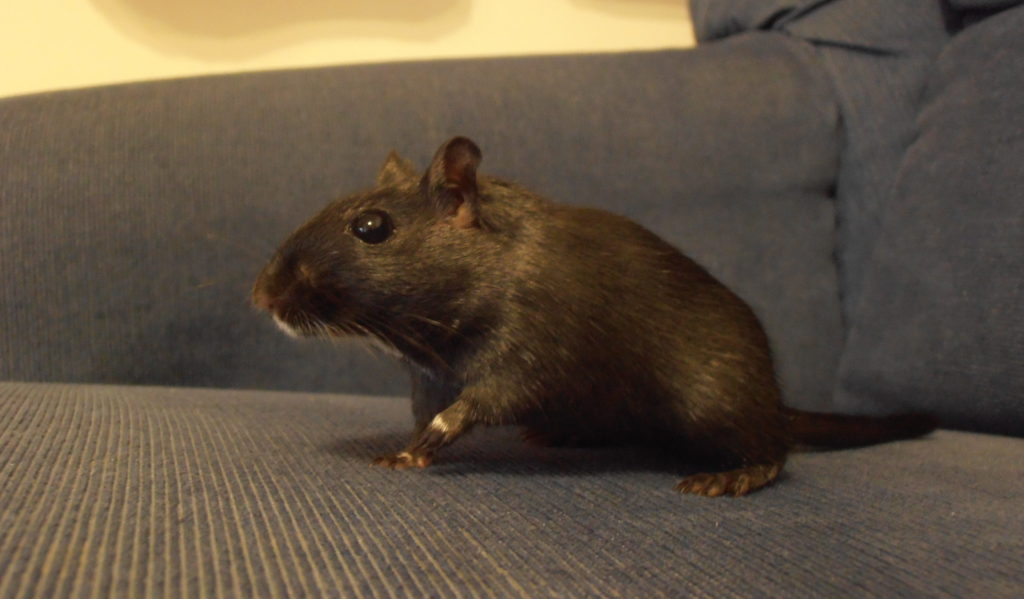We have all been there – come home to find the gerbil’s enclosure open and nobody home!
That moment of dread wondering where they could be and whether they are still safe.
Rule Number 1 is always immediately – and watching every step – close the door to that room (no matter how big that room is and whether it contains a network of other rooms and hallways). Seal off all exits to the room with the enclosure in it and warn all family members to tread carefully.
Help – my gerbil has escaped!
Key points to remember in catching a gerbil safely involve the following main steps. You might not catch a gerbil in one day because until you know which room it is definitely in – you can’t watch it and set up the ‘catch trap’.
- Seal off all rooms – starting with the one the enclosure is in
- Remove all cats from the house until you find that gerbil
- Time is of the essence if you have more than one gerbil in that enclosure
- Silence and patience are key here – make sure you have plenty of both before starting
- Gerbils love following repetative paths – watch them and learn where they go
- Set up a funnel to an enclosed section-off area, concealed container or drop bucket
So, once you have ingested the above list and sealed off the main gerbil room – then follow these steps as closely as you can – tried and tested by ourselves MANY times.

Step 1: The Gerbil Enclosure Room
It is very likely that your gerbil is still in the same room as their enclosure – and they may even have tried to get back in it before you got home. So, once you have closed the door to this room – create a small pile of counted-out large-piece food (ideally sunflower seeds) in a very precise pile visible from the door to that room – but make sure it is close to anything the gerbil could be hiding under.
This way, you can start to locate the gerbil without even being in the room – i.e. have they eaten the sunflowers – because the next steps are elsewhere in the house. However, if you have another useful human with you (hello other human) – have them sit totally still in this one room – on listening duty – while you head off for Step 2.
Tell them that even if they hear any noise – they themselves must stay still and silent to encourage the gerbil to be bold and show themselves again – as knowing what they are hiding under is a great start.
Step 2: Safety Measures For Your Gerbil
If you are alone or you have left a second person in the Enclosure Room, you must head off and close all doors to all other rooms, including the bath, toilet and kitchen where possible. You can’t catch a gerbil until you know what room they are in and can keep them there.
Remove all cats from the house immediately, and contain any dogs that are likely to chase your gerbil – if they are a good sniffer and have previously ALWAYS been safe around the gerbils – they may be able to be supervised to help you locate the room with the gerbil in it! Put them on a lead and keep them with you.

After the cats are gone, try to think of any ‘danger zones’ like the holes under the bath, or behind that loose skirting board in the kitchen. The broken ventilation panel in the wall through to next doors or out into the garden – these are all far more important than searching the rooms you think they are already in.
I mean if you think they are already in the front bedroom – closing the door behind them means they will still be in there as before. But thinking they are in the front bedroom and sitting in there for a half hour listening first – means that if they were actually in the bathroom – they have now found those holes under the bath!!!
Next, make sure you advise all people in the house – or who will potentially be returning to the house within the next few hours – of the issue and ask them to stay out for longer where possible, or to come in quietly and close all doors behind them.
I know you might be thinking – “I can tell them that when they get home” – but believe us – after you have been standing still and silent for 45 minutes waiting for your gerbil to FINALLY walk into that section you have spent ages building and coaxing them right next too – the LAST thing you want is someone coming in a scaring them away by inadvertently swinging open the door and shouting – “hey, why are all the doors closed!”
It genuinely has happened!

Step 3: Setting The Gerbil Trap: Treat Piles
Clearly – unless you are lucky and have company (or have gerbils that always answer to their names) – the only way to find them is to sit in each room and listen for at least 30 minutes.
You need to be totally still and totally silent – so that every noise is amplified. You don’t need to actually see the gerbils to know where they are. This isn’t fun and takes ages – but there we are – it is essential.
As this takes time – a helpful aid to this search is to create those tasty but well-organised piles of (counted) treats in each room. This way, all the while you are in other rooms listening carefully – those treats may become very attractive to your gerbil – and once you enter a room and see the piles disturbed – BINGO. You know where they are and the catching can commence!
If you have that gerbil-sniffing dog – this is where they come into their own.
However, if you are too busy to catch them now – don’t have a gerbil-sniffing dog – it is too late for any reason – or you haven’t yet located the room they are in – you just need to make this room or the main rooms where you think they are gerbil secure and gerbil healthy.
So, defo leave the piles of food, but maybe add a water bowl for them. Add a nest box in the corner or along the skirting with some nesting material in it (incase they use it or are cold), and potentially add an ingenious (or just whatever you can muster) drop trap just incase – so a container with a ramp up one side and something interesting or tasty in the middle so they are tempted to drop in – but then can’t get back out.
Make sure the food in here is moist (seeds or veg) incase they are in it for hours – and always leave your original treat pile outside of it so they can still eat even if they don’t fall for the trap – and you can still see if they are in the room and alive.

Step 4: The Gerbil Catching Funnel
Once you have identified the room they are in – it is easy from here on in – although it might still take an hour or so of patience depending on what else is in your room.
If you have really well-behaved gerbils – just calling their names and running your fingers on the carpet/flooring may be enough to draw them out – or maybe a fresh dust bath could work wonders. You do need to be quite close to this though otherwise they come out but run off again when you go to catch them.
Bear in mind too that having been out and about and potentially quite scared for a few hours – your normally-friendly gerbil may act very differently – and could accidently bite you in a panic – so please be careful approaching them in these circumstances.
Perhaps having a carrier or large box or bowl with you in the room will be a great help as them when you do catch them you can put them in this easy-to-access temporary enclosure without having to faff about with opening cage fastenings and things. Believe you me – it is far better to catch a gerbil and pop them in such a container anyway.
Not only is it easier and quicker – it will also allow you to check them over for injury; make sure they eat and drink something; and help calm them down – rather than shove them straight back into a warren of tunnels where you might not see them again for hours.
For catching – a large pot, tub or bowl can help as gerbils are known for being nosey and might just walk in to it after not too long – especially if it has a mealworm in it – or a raisin! Sometimes even a kitchen roll tube will do – they really can’t help themselves.
If this doesn’t work then move on to more extensive actions.
Start by watching where they return to and where they walk to each time – gerbils seem to repeat various routes when out and about in unchartered territory – and you can use these repeat visits to corner them in a safe zone – perfect for catching.
So, while sitting still and quiet in the room have a think about places in the room where you could create your funnel: a wide-mouthed entrance to a series of shut offs ending in a high-sided dead end. You may need, trays, boards, lids and such to create this segmented funnel – it depends what you have to hand. Sounds exciting, right?
Then – once you are happy with your plan – get your equipment together for the funnel – the shut off doors – the catching pot – and some treats.
Set up your funnel – but make sure your gerbil isn’t scared off to a new location as this could change your plans again.
The number of shut off you need depends on the stuff in your room in the way. It may be that you only have a cupboard in one corner – so guiding the gerbil out from under that and down the wall into your catch pit is as simple as that?
However in most homes, there are places with more junk than others, as well as things you can’t see under, so set up your funnel to make sure they can’t stay under the lowest things and can’t double back into a new zone.
Step 5: Patience Is a Virtue
Here is the fun bit – but often needing the most patience depending on the first section of the funnel. Position yourself well – on the ground. Close enough to the first shut off door – but a bit behind the original location of your gerbil so you can coax them to run into your funnel, but can get there SAFELY in time to close this first door behind them while they are still inside.
If you move to early – they may double back – shoot out sideways or leap in the air!
You need to make sure they are past the point of no return before moving in. This can sometimes involve you watching them go really close to it – but not quite in, and then running back to the start point for a bit, and then trying again.
Just remember this whole time how scared they might be, so take your time.
When they finally enter the first shut off, block them in with a swift move. This in another reason why you need to make sure they are commited – as if they try to run back out while you are in mid block – you could squish them – and nobody wants that! You are trying to catch them to keep them safe – so make sure you don’t accidently rush this.
If you are waiting for them to get inside a different room for this first step, that can be the most painful. We remember one night standing in our hallway, waiting for the gerbil to come fully out of the kitchen, along the hallway a bit and into the lounge. Darn these open plan houses! There was no way to catch them under the kitchen units, the hallway was too big, and there was no door on the lounge, so we just had to wait for them to come out of their own accord.
My, that was painful.
We think we were stood there about 2 hours in the dark – waiting. We ALWAYS blocked off the lounge entrance from that day onward – we were NOT having that again!
However, once they are in slightly less open area, you can move in with the treats and final trap zone. Gradually moving through your cut-off zones with mealworms and toilet rolls until you are in the last section – the dead end.
Step 6: Catching Your Escaped Gerbil
Here, you are spoilt for choice. The catch-pot. The jar. The tunnel-trap. The hand catch.
Give your poor gerbil a chance to realise they are in the last zone – it is safe. Reassure them with your voice, and get your large tub ready, or have their enclosure brought real close before catching them. They will be panicked, you will be stressed – just wait until everything is ready before finally catching them.
If they are a lone gerbil – popping them straight back into their enclosure once you know they aren’t injured is fine – but sometimes it’s not as easy for pairs and trios as gerbils can be really stroppy with runaways.
If they are in a pair and have been separated for their tank mate for anything up to a few hours, they should be fine to go straight back in together – although this could certainly mean for a lot of extra sniffing, mounting and rubbing depending on whether the escapee is the Boss or not. Certainly keep an eye for a while after re-introducing – and offer lots of distractions like treats, a sandbath and something new to chew.
If they are part of trio – this may be more stressed – but it is still possible – so again, watch and distract until you are happy they are getting on again. With three possible bosses, it is less likely the one who escaped was the one in charge which is what increases the risk of scuffles.
If it was a longer time apart – say overnight – then both combos are still possible – but less likely to be stress-free as your escapee won’t smell to much like them anymore – and could smell like cat, dog, chocolate or cobwebs – totally alien to the gerbils who stayed home.
Best course of action is to take OUT the remaining gerbils from their enclosure and put them in the run or bath tub – then put the escapee back in the enclosure and cover them in the used substrate making the escapee camoflague themselves back in. Give them a good 20 minutes or so in there alone to get all back and ready – then stick the other gerbils back in and hope that THEY then feel like the odd ones out and ask the escapee if they can join back in.
Distract with treats, dust bath and tubes – and leave to simmer – watching closely.
Can You Reintroduce Gerbils If They Have Been Lost For Days?
Gerbils seem to have a very short memory sometimes of how they used to live – I think they do it on purpose. Like when you have someone at work you find quite overpowering, and they finally get promoted – your office will subtley have a reshuffle to a new ‘agreement’ – a new happy balance. However, if they come back a few days later, their status in the group won’t ever quite be the same – you all have a new confidence.
Gerbils are in quite a delicate balance too – so once one gerbil has gone, the remaining gerbils might start a new life for themselves as the new Boss. Moreso if they were a trio and now they are just a pair – as they now need to decide on a new boss and it might not be an easy decision for them to make. Gerbils don’t shake hands: one of them beats the other one up!
So, if your once-friendly gerbils don’t get on after their time apart (like having ball fights) or they have been apart for several days since going missing and you aren’t happy to put them straight back in their original clan – then you will need to keep them apart temporaily and create yourself a simple but secure split cage – just to re-introduce them to each other so they can re-adjust more safely.
It won’t be like a full split intro – but the split needs to be secure just the same.
It will be best to pull out some used substrate from the original enclosure for both sides of the split – and somewhere undercover to sleep from the same enclosure like a coconut shell or tunnel. Swap the gerbils over between sides 3 or 5 times a day for a couple of days only – then when you are there to watch one day or evening – remove the split and see what happens – be ready with a cup or pot just incase.
Hopefully the time back together – but not together – keeps everyone safe – and allows them to be friends again.
If it doesn’t quite work out first time (but no massive bloodbath) – give them a few more days in the split and try again.
If it doesn’t work out a second time – or they have a serious fight – then perhaps their time has passed and they need to be housed seperately to each other. Especially with a trio – as the remaining pair might get stressed and start to fight too! And that’s the last thing you need.
That isn’t to say that the lone gerbil or gerbils (if you had an original pair) can’t be paired up with a new friend each – it just means that they themselves can’t be a clan anymore. Gerbils easily move from one clan to another so isn’t a problem in itself.
It is for you though – as now you need a second enclosure!